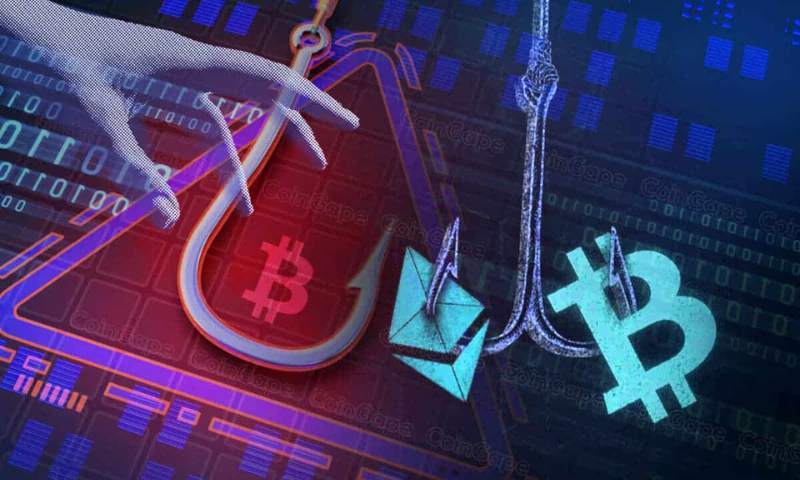Beware of Phishing Attacks in Crypto 2024: Secure Your Digital Fortunes Now! Dive deep with me into the murky waters of crypto security, where phishers lurk, preying on both newbies and seasoned traders. As an expert, I’ve seen the tactics evolve. Your digital wallet’s safety hinges on insight and action—and that’s exactly what I’m here to share. This year, more than ever, your vigilance is the armor against these crypto cons. Stick with me to learn how to sniff them out and secure your stash before they can bait you. Let’s lockdown your crypto together.
Understanding the Landscape of Crypto Security in 2024
Evolving Threats: The Latest Phishing Tactics in Cryptocurrency
Crooks get clever every year. Phishing in crypto is no exception. Back in the day, they’d fake emails. Now, they’re way ahead. Imagine getting a message, looks just like it’s from a trusted friend, right? But here’s the catch—it’s a scam. Crypto security tips 2024 are all about outsmarting these new tricks.
These scams tug at your trust. One click and you might give away your digital keys. That’s why being aware is your crypto armor. Common crypto phishing techniques include fake websites and messages. They might look like the real deal. But look closer. Tiny details can save your assets.
The scammers make websites duplicate real ones. They’ll swap out just one letter in the URL. You miss it, you might just miss your crypto too. Securing crypto wallets starts with eagle eyes and quick thinking.
The Importance of Recognizing Phishing Attempts
Now, knowing what a phishing scam looks like—that’s half the battle. If a crypto deal feels too good to be true, it probably is. The importance of recognizing phishing attempts can’t be overstated. Phishing awareness in crypto is like knowing the rules of the road before driving. You need it to stay safe.
Spotting phishing emails is your first line of defense. Look for off spelling or weird requests for info. No legit company asks for your keys over email. And those DMs on social then? They could be traps. Phishing through social media crypto scams is a big thing.
Avoiding crypto fraud means asking questions. Where’s this link taking me? Is this website legit? Identifying fake crypto exchanges is crucial. Look for security features like two-factor authentication. This is a sign you are dealing with safe crypto transactions.
Scammers prey on quick moves. So make slowing down your superpower. Before you click, pause. Think: Is this real? Safeguarding against crypto scammers is about staying calm and in control.
Phishing red flags are your warning signs. They help you stay a step ahead of bad actors. Education on crypto phishing is your shield and sword in this fight. Because when it comes to your crypto, you’re the hero of your own story. Protecting digital assets is about using that power wisely.
Crypto in 2024 is exciting, but also a field where smart moves matter. By now you’ve learned the basics of phishing defense strategies. Next, we’ll dive into how you can be proactive in this ongoing battle. Remember, a smart crypto investor is a secure crypto investor.
Safeguarding Your Cryptocurrency: Effective Defense Strategies
Implementing Robust Phishing Protection Measures
Crypto security tips start with knowing the bad guys’ moves. Think of phishing like fishing. Scammers toss out bait to catch you. Only their bait looks like real emails or sites from your favorite crypto spots. So what do you do? Spot the fake stuff before it gets you.
Securing Crypto Wallets and Transactions
Your crypto wallet is like a vault. Keep it locked tight. To avoid crypto fraud, use top-notch ways only you know to open it. Like two-factor authentication—use it. It puts another lock on your crypto vault.
Now, let’s talk hard facts about scams. Crypto investment scams trick smart folks daily. How? By dressing up like the real deal. Phishing emails might promise big wins or urgent actions. Spot them by looking for odd links or misspelled words. Those are big red flags.
Latest phishing tactics in cryptocurrency are slick. They can fool anyone, not just new folks. Scammers may use emails, texts, even social media, claiming they’re from real crypto businesses. They want you to bite and give them your keys. Don’t. Always double-check who you’re talking to.
Having strong phishing defense strategies is big. It means being one step ahead. Always check the website address. If it’s off by even one letter, it could be a fake. Keep an eye out for secure locks or security seals on sites too. Phishing attack indicators are there; you just need to look.
Scammers also make fake pages that look like well-known crypto exchanges. Identifying these fake crypto exchanges can be tricky. They look real but always check their credentials. Every real exchange has signs that show they’re legit. Look for verifications and user reviews.
What about phishing through social media in crypto? Yes, it’s real. Scammers hit you up through DMs or fake ads. They might ask for your login info. Never share it. Real companies won’t ask for that in a message.
Email security for crypto investors is huge. Protect email like you protect your crypto coins. Use different passwords for different things. That way, if scammers get one, they can’t get to everything you have.
Make use of anti-phishing tools for crypto. There are apps and extensions that can warn you about risky clicks. They can be your best friend in staying safe.
Blockchain security practices are evolving, just like crypto. But the basics matter most. Keep your eyes open and question things that seem off. And remember, if a deal seems too good to be true, it probably is—especially in crypto.
Keep learning about phishing awareness in crypto. Knowing about it is half the fight. The other half is being smart with your crypto moves. Always ask questions, and never let your guard down. Transactions should only happen on secure cryptocurrency platforms—ones people know and trust.
Preventing crypto phishing incidents is a team effort. Help out by reporting shady stuff. Share your know-how with others. By teaching and learning, we protect each other. We all want to keep our crypto safe. So let’s do it together. Let’s make sure our digital fortunes stay just that—ours.
Identifying the Red Flags: How to Spot Phishing Attacks
Recognizing Phishing Emails and Avoiding Fake Crypto Exchanges
As a crypto user, you must stay sharp. Every day, scammers try to trick us. Their emails look so real! But we can stop them. How? Know the warning signs. A real crypto company will never ask for your private keys. If an email does, that’s a big red flag. Also, watch out for bad spelling or odd email addresses. These are signs of a phishing scam.
Phishing emails often want you to click on links. Don’t do it! They might look like real crypto sites but they’re fake. These sites steal your information. Always check the web address. Make sure it matches the official one. A secure crypto exchange uses HTTPS, not just HTTP. That ‘S’ is super important—it stands for security.
We also need two-factor authentication (2FA) for an extra layer of safety. It’s like having a secret handshake only you and the crypto site know. Without 2FA, your wallet might be easier for scammers to get into. Secure cryptocurrency platforms always offer 2FA. Use it to keep scammers out.
Phishing Awareness: From Social Media Scams to Bogus Crypto Giveaways
Social media is full of traps. Scammers might pretend to be famous people. They promise free crypto if you send them some first. But think about it. Why would someone give away free money? It’s a trick to steal your coins.
Scammers also make fake profiles. They’ll message you, acting like your friends or a support team. They want to trick you into giving them access to your wallet or sending money. Always double-check who you’re talking to. Look at their profiles. If something feels off, it’s better to be safe and ignore the message.
Avoid crypto fraud by making smart choices. Don’t take part in giveaways that seem too good to be true. Protecting digital assets means being careful who you trust. Never share your wallet’s secret info. And don’t let big promises trick you. Always stop and think before you act.
Bogus crypto giveaways often happen during big events. Scammers know people are excited and might not be thinking clearly. They take advantage of this and rush you to make a mistake. Take your time. No real giveaway will need you to act in seconds. If they hurry you, it’s probably a scam.
We can keep our crypto safe by watching for these tricks. Phishing red flags are our clues to spot the bad guys. If we recognize phishing attempts and stay aware, we can keep our digital fortunes secure. It’s all about being smart and careful online. Let’s keep our crypto safe together!
Empowering Users Through Education and Tools
Anti-Phishing Tools for Crypto Investors
To fight crypto scams, we need solid tools. Imagine a shield for your digital cash. That’s what anti-phishing tools do. They check links and emails for trickery. Some tools even alert you of bogus sites. Always check for two-factor authentication (2FA). It adds a safety step for access. This year, more tools will pop up.
Building a Culture of Security with Crypto Anti-Phishing Protocols
We must all learn to spot the sneakiness of scammers. Crypto phishing has red flags. Odd emails asking for private keys are a huge no. Security comes from our habits and awareness. Watch out for offers too good to be true. They probably are. Good habits keep our digital fortunes safe.
Know this: Crypto security tips for 2024 are our digital armor. They arm us against the sly moves of online thieves. Your first task is to know the common crypto phishing techniques. These include fake sites that look real, and emails that seem legit. Always step back and think before you click.
Recognizing phishing attempts can save your coins. Did you get an email from a stranger about crypto? It could be a scam. Check who sent it. Is the address strange? Does it use fear or urge you to act fast? These could be phishing attack indicators. Trust your gut. If it feels off, it probably is.
Don’t fall for fake everything. Scammers set up fake exchanges, offers, and wallets. They want you to think they are real. But a close look will show the cracks. Is the website address funny? Are there spelling errors? Does it lack secure features like a padlock icon? Say no to these traps.
Stick with safe crypto transactions. Use platforms known for their security. They have the muscle to fight off frauds. Avoid just any new exchange or wallet. It could be a setup by scammers.
We all have to play our part in preventing crypto phishing incidents. This means talking about it. Share your knowledge on how to avoid crypto fraud. If we all know more, we can fight back better. Education on crypto phishing is vital. Stay updated on the latest phishing tactics cryptocurrency crooks use.
Most important is safeguarding against crypto scammers. This keeps your investments safe. You worked hard for your crypto. Protect it like a guarded treasure. Remember, anti-phishing tools for crypto investors are key. They watch your back while you grow your digital wealth.
Shield your coins. Make use of the best blockchain security practices. Have a sharp eye for phishing red flags. Invest in your knowledge as much as you do in your portfolio. Creating a culture of security takes all of us in the crypto world. When we stand together, scammers don’t stand a chance.
In this post, we dived deep into crypto security. We started by looking at new phishing dangers in crypto. It’s key to know these risks to stay safe. Realizing when someone is trying to trick you is a must. Then we covered how to protect your crypto. We learned solid ways to stop phishing. Keeping your crypto wallet and buys secure is a big deal.
Next, we talked about spotting phishing tries. We saw how to spot bad emails and fake crypto markets. Knowing these can save you from scams. You learned about tricks like fake social media offers and giveaways too. Last, we went over tools and knowledge that can help. With the right anti-phishing tools and a strong security mindset, you can keep your crypto safe. Remember, education is your best shield. Let’s keep our crypto investments safe. Stay alert, keep learning, and use the best tools out there.
Q&A :
What are phishing attacks in cryptocurrency, and how can you avoid them in 2024?
Phishing attacks in cryptocurrency involve scammers using fake communications, such as emails or messages, that appear to come from legitimate sources. These communications aim to trick individuals into providing sensitive information, such as private keys or login credentials. To avoid phishing attacks in 2024, always verify the authenticity of the message source, use two-factor authentication, and never share your private keys or sensitive information with anyone.
How can you recognize a phishing attempt related to crypto in 2024?
Recognizing phishing attempts in the crypto world in 2024 means staying alert for suspicious signs. These can include unexpected requests for private information, alarmist messages urging immediate action, and email addresses or links that differ slightly from the legitimate source. Always double-check URLs, look for secure connections (HTTPS), and be wary of downloading attachments or clicking on links from unknown senders.
What should you do if you suspect you’ve been targeted by a phishing attack in the crypto space?
If you suspect you’ve been targeted by a phishing attack in the crypto space, act quickly. Avoid clicking on any links or downloading attachments from the suspected source. Change your passwords immediately, and enable two-factor authentication if you haven’t already. Report the attempt to the legitimate company being impersonated, and consult with cyber security experts if necessary.
Are there any new methods of phishing attacks specific to crypto that are emerging in 2024?
As technology evolves, so do phishing methods. In 2024, attackers may use advanced tactics like deepfake videos or voice cloning to impersonate trusted individuals or companies. Social engineering attacks targeting specific individuals or groups, known as spear phishing, may become more sophisticated. Stay informed on the latest security threats by following reputable cybersecurity resources and updating your security measures accordingly.
What are the best tools and practices for protecting your crypto assets from phishing attacks in 2024?
To protect your crypto assets from phishing attacks in 2024, use reputable and updated security software that includes phishing detection. Employ hardware wallets to store your cryptocurrencies offline. Always keep your software and wallets up to date to ensure you have the latest security features. Additionally, educate yourself on the latest phishing techniques and be cautious when handling unsolicited communications related to your crypto assets.






